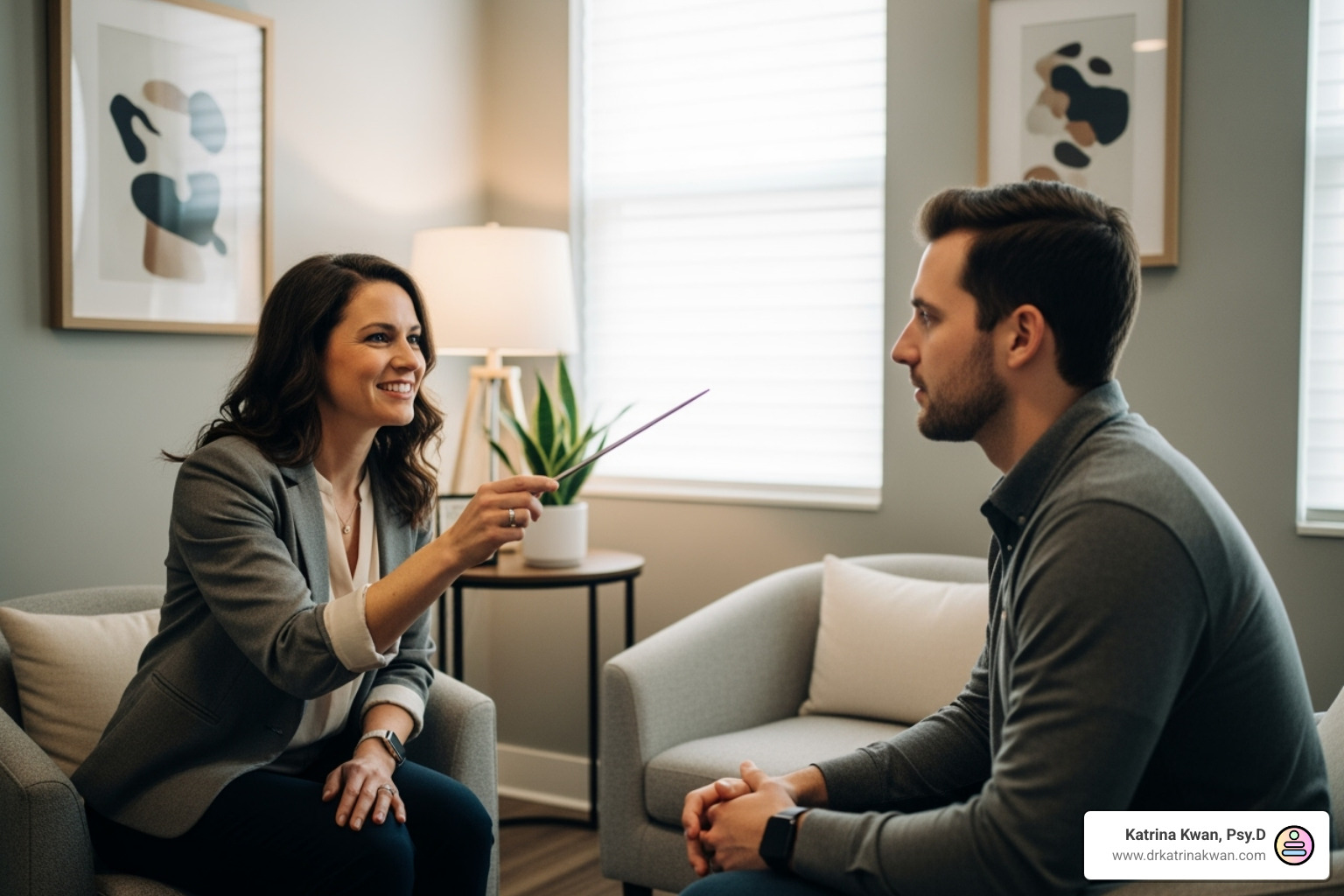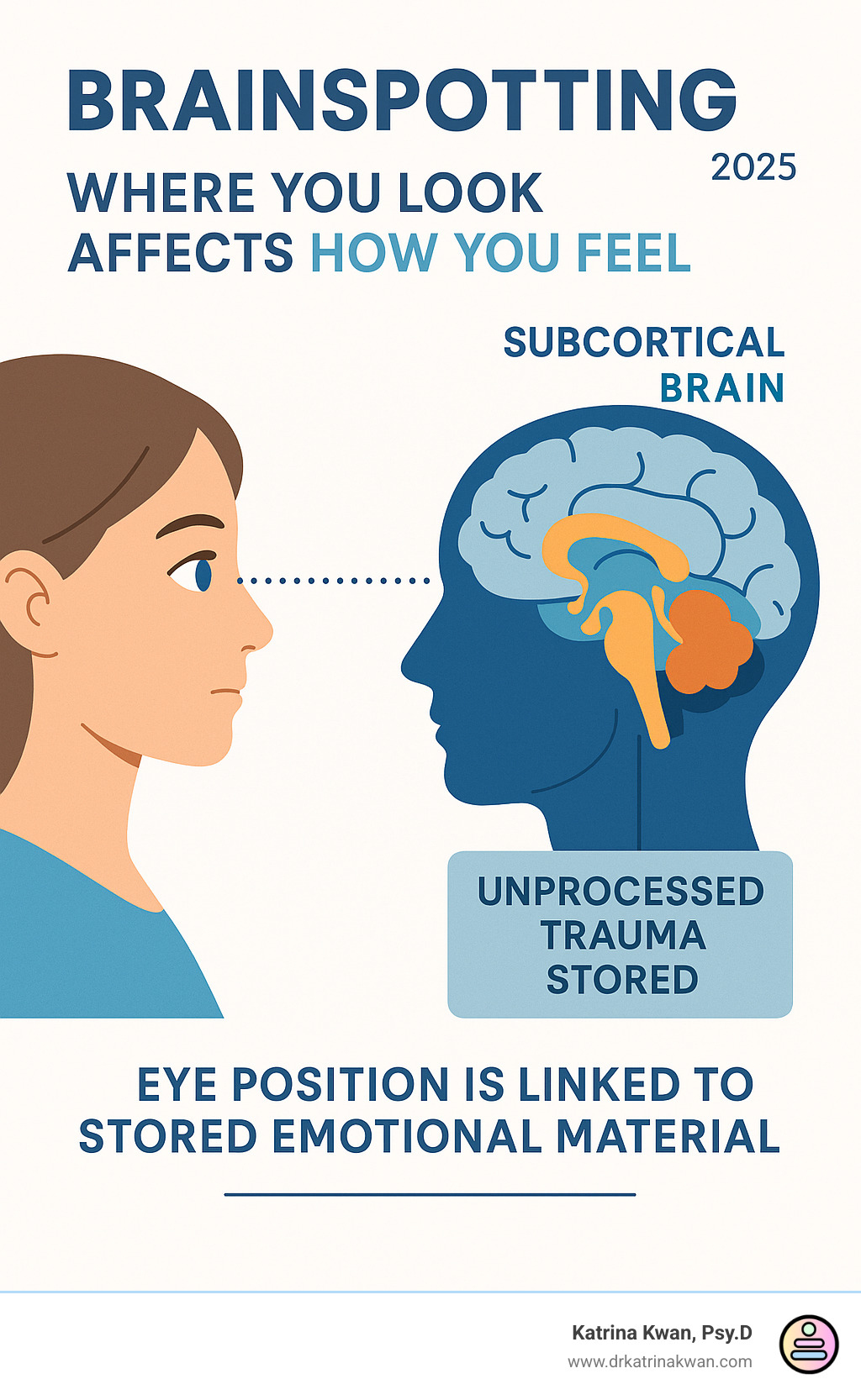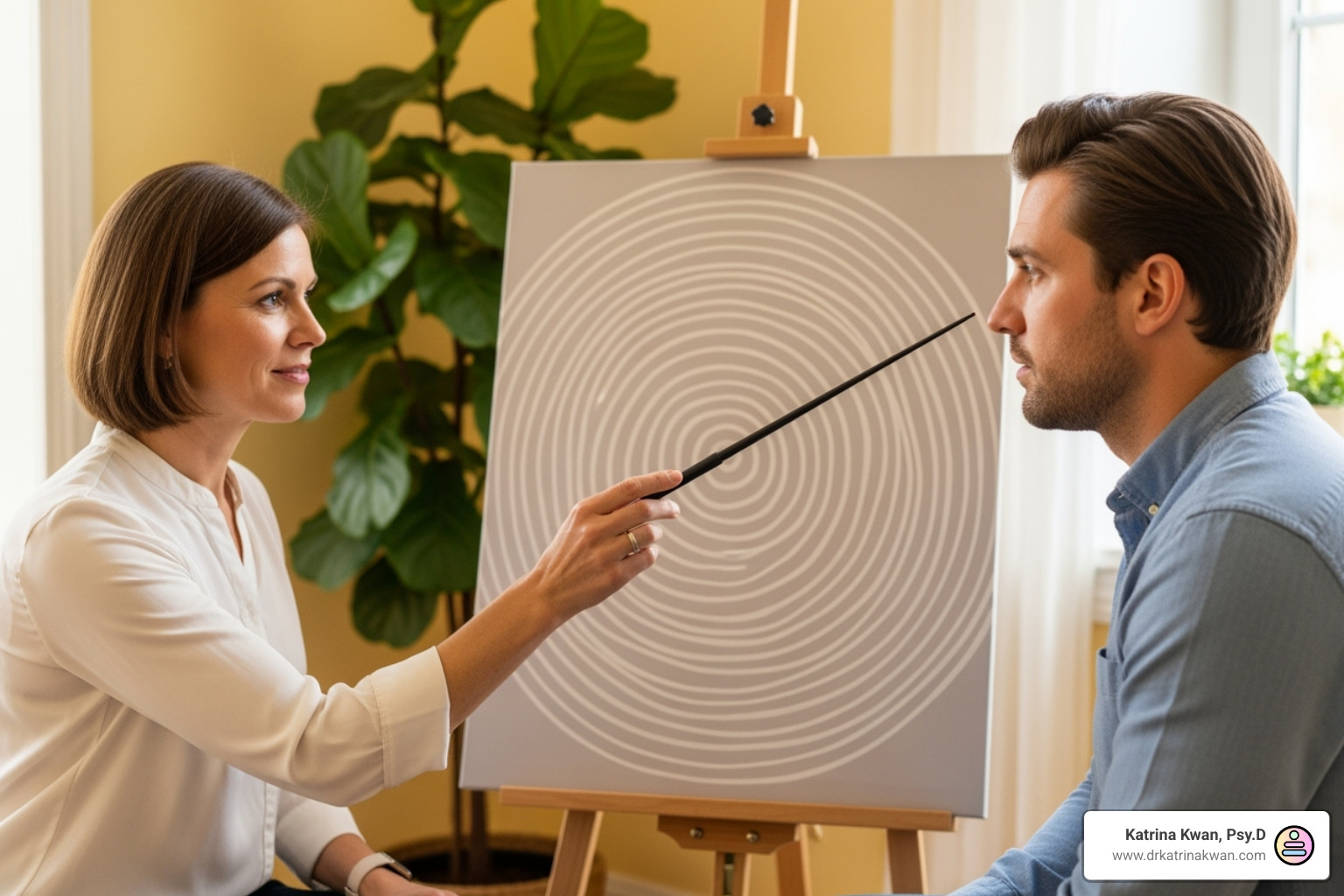Understanding Your Certified Brainspotting Therapist: A Path to Deep Healing and Mental Health Recovery

Why Working with a Certified Brainspotting Practitioner Matters for Your Journey
When you're seeking healing from trauma, anxiety, or depression, choosing the right therapeutic approach can feel overwhelming. If you've tried traditional talk therapy but still feel stuck, you might be wondering about alternative therapy options that work differently with your nervous system. As a certified brainspotting therapist, I understand that finding the right mental health professional for your healing journey requires knowing what qualifications and expertise to look for.
Brainspotting therapy represents a unique alternative therapy approach to trauma and emotional healing that goes beyond traditional talk therapy. Founded in 2003 by Dr. David Grand, this powerful modality operates on the principle that "where you look affects how you feel." Unlike conventional therapy approaches, brainspotting therapy accesses the subcortical brain—those deeper, non-verbal areas where trauma often becomes stored in your nervous system.
I am Dr. Katrina Kwan and I've seen the power of Brainspotting, a method pioneered by Dr. David Grand. He finded that specific eye positions can open up access to traumatic experiences and emotions stored in the body. Grand's groundbreaking work showed this brain-eye connection offers a direct path to processing trauma at its source. In my sessions, clients often lose track of time as their brains engage in deep healing. This findy has truly revolutionized how I approach trauma therapy.
Understanding Brainspotting Practitioner Qualifications and Training
When seeking a brainspotting therapist, understanding the different levels of brainspotting training and brainspotting certification is crucial for your safety and healing outcomes. The field has specific standards that distinguish between various practitioner levels, and these differences can significantly impact your therapeutic experience with brainspotting therapy.
The Distinction Between Trained and Certified Brainspotting Practitioners
A therapist who is "trained in brainspotting" has typically completed brainspotting Phase 1 training, which provides foundational knowledge about the approach. However, becoming a certified brainspotting practitioner requires a much more comprehensive and rigorous process that demonstrates deeper commitment to mastering brainspotting therapy techniques.
Here's what distinguishes a certified brainspotting practitioner from other mental health professionals:
Brainspotting Phase 1 and Phase 2 Training: Six days of intensive brainspotting training covering both foundational concepts and advanced methods for working with diverse client presentations in brainspotting therapy.
Direct Brainspotting Practice Hours: A minimum of 50 hours of direct brainspotting practice with clients, ensuring real-world application of brainspotting therapy skills.
Individual Consultation with Approved Brainspotting Consultant: Six hours of one-on-one consultation with an approved brainspotting consultant, providing personalized feedback and refinement of brainspotting therapy techniques.
Brainspotting Certification Standards: Adherence to the Brainspotting Code of Ethics and brainspotting certification requirements, prioritizing client safety and professional integrity in brainspotting therapy.
Advanced Training and Ongoing Education: Commitment to continued learning and professional development within the brainspotting therapy community through additional consultation with brainspotting consultants.
This comprehensive brainspotting training ensures that when you work with a certified brainspotting practitioner, you're receiving care from a mental health professional who has not only learned the theory but has also applied brainspotting therapy extensively under expert supervision. As a certified brainspotting therapist with advanced training, I've completed this rigorous brainspotting certification process to ensure I can safely guide you through the complexities of trauma therapy and nervous system healing.

How Brainspotting Therapy Facilitates Deep Healing
Understanding how brainspotting therapy works can help you feel more confident about this alternative therapy approach to healing. The process is both scientifically grounded and intuitively natural, working with your brain's innate capacity for healing and integration through brainspotting sessions.
The Brain-Body Connection in Trauma Processing
Trauma doesn't just live in your thoughts or memories—it becomes stored in your nervous system and deeper brain regions. Even when you intellectually understand your traumatic experiences, your nervous system may remain stuck in survival mode, creating ongoing symptoms like anxiety, panic attacks, hypervigilance, or emotional numbness. This is where brainspotting therapy becomes particularly effective as an alternative therapy approach.
Your eyes connect directly to your subcortical brain, including the limbic system and brainstem, which govern emotions and survival responses. Traumatic memory often becomes frozen in these non-verbal areas rather than being properly processed and integrated. This is why talking about traumatic experiences, while valuable, sometimes isn't sufficient for complete mental health recovery.
During brainspotting sessions, I help you identify specific eye positions—called "brainspots"—that connect to stored distress in your nervous system. As you maintain your gaze on these eye positions, you may notice body sensations, emotions, or traumatic memory emerging. This brainspotting phase bypasses your thinking mind, allowing direct access to where trauma is held in your body and brain through focused brainspotting work.
The Role of Bilateral Sound and Nervous System Regulation in Brainspotting Sessions
In my brainspotting therapy practice, I often incorporate bilateral sound using specialized audio tracks that help both hemispheres of your brain work together more effectively during brainspotting sessions. This auditory support enhances feelings of safety and calm while you process difficult material, creating optimal conditions for healing and integration in brainspotting therapy.
The bilateral stimulation helps regulate your nervous system during the brainspotting phase, preventing you from becoming overwhelmed while still allowing meaningful therapeutic work to occur. This careful balance between activation and regulation is crucial for safe and effective trauma therapy and treating trauma through brainspotting sessions.
What to Expect in Your Brainspotting Therapy Journey
Many people wonder what brainspotting sessions actually look and feel like. Understanding the brainspotting therapy process can help reduce anxiety about trying this alternative therapy approach that differs from traditional mental health treatment.
Your First Brainspotting Sessions and Beyond
When you begin brainspotting therapy with me, I start with a comprehensive consultation to understand your history, current mental health challenges, and healing goals. I believe in taking time to build safety and trust before beginning any deep brainspotting work. During our initial brainspotting sessions, I'll explain how brainspotting therapy works and answer any questions you might have about this alternative therapy process.
Finding Your Brainspot Eye Position: When you're ready to begin the brainspotting phase, I'll ask you to think about an issue or feeling you'd like to work on during our brainspotting sessions. You don't need to share extensive details—sometimes just a general feeling or body sensations is enough to begin brainspotting therapy. While you hold awareness of this issue, I'll guide your gaze using a pointer, watching for subtle reflexes that indicate we've found a relevant eye position for effective brainspotting work.
The Brainspotting Phase of Processing: Once we locate your brainspot eye position, you'll maintain your gaze on that position while simply noticing whatever arises during brainspotting sessions—thoughts, feelings, body sensations, images, or traumatic memory. There's no need to analyze or make meaning of what comes up; your job during brainspotting therapy is simply to witness and allow your natural processing to unfold. Many clients report a felt sense of deep release during this brainspotting phase.
Integration and Closure After Brainspotting Sessions: Each session includes time to help you integrate your brainspotting therapy experience and return to a regulated state before leaving. I provide guidance on what you might expect in the days following brainspotting sessions and offer tools for supporting yourself through the integration process of brainspotting work.
The Mental Health Conditions I Address Through Brainspotting Therapy
In my brainspotting therapy practice, I've found this alternative therapy particularly effective for addressing the nervous system components underlying many mental health challenges. The adults I work with often come to me when they feel stuck despite having tried other therapy approaches for their mental health concerns.
Trauma and PTSD Through Brainspotting Therapy: Whether you've experienced a single traumatic experience or complex, ongoing trauma, brainspotting therapy can help your nervous system process and integrate these experiences. This alternative therapy approach is gentle yet thorough, allowing healing to occur at your natural pace while treating trauma at its source.
Anxiety and Panic Attacks: Anxiety and panic attacks often involve an overactivated nervous system that remains stuck in alert mode. Brainspotting therapy helps identify and release the underlying activation patterns, creating lasting relief from anxiety and panic attacks rather than just temporary symptom management. Many clients find their panic attacks decrease significantly after brainspotting sessions.
Depression and Emotional Pain: Depression frequently involves suppressed emotions or unresolved grief. By accessing these feelings through the nervous system rather than just through talking, brainspotting therapy can help restore your natural emotional range and vitality, addressing both emotional pain and depression symptoms.
Overwhelm and Nervous System Dysregulation: Modern life can overwhelm our nervous system, creating chronic stress and difficulty with emotional regulation. Brainspotting therapy helps restore your nervous system's natural capacity for resilience and flexibility, allowing you to feel safe in your daily life.
Neurological Conditions: I also work with individuals recovering from strokes, traumatic brain injuries, and other neurological conditions through brainspotting therapy. This alternative therapy can support nervous system reorganization and integration during recovery processes, helping clients regain function and reduce pain.

Integrating Multiple Healing Modalities with Brainspotting Therapy
As a certified brainspotting practitioner trained in multiple somatic approaches, I understand that mental health healing rarely happens through just one method. In my brainspotting therapy practice, I integrate this alternative therapy with other evidence-based approaches to create personalized treatment plans that address your unique mental health needs and life goals.
Safe and Sound Protocol (SSP) with Brainspotting Sessions
The Safe and Sound Protocol is a listening therapy that helps regulate your nervous system through specially filtered music. I often use SSP alongside brainspotting therapy to enhance your nervous system's capacity for regulation and social engagement. This combination creates optimal conditions for brainspotting sessions while maintaining safety and stability throughout the brainspotting phase.
Somatic Experiencing and Brainspotting Work
Somatic Experiencing focuses on completing interrupted survival responses and restoring natural nervous system regulation. I integrate these principles with brainspotting therapy to help you develop greater awareness of your body sensations and learn to trust your body's wisdom in the healing process. This combination enhances the effectiveness of brainspotting sessions.
Accelerated Resourcing in Brainspotting Therapy
This approach focuses on identifying and strengthening your natural resilience and coping resources before addressing areas of difficulty in brainspotting sessions. By building your capacity for self-regulation first, we create a stronger foundation for treating trauma safely and effectively through brainspotting therapy.
The Personalized Nature of Mental Health Healing
One of the most important aspects of my brainspotting therapy approach is recognizing that every person's mental health and healing journey is unique. There's no standardized timeline or predetermined outcome that I expect you to achieve through brainspotting sessions. Instead, I focus on connecting you with your own innate healing abilities and helping you recognize what works specifically for you in brainspotting therapy.
During our brainspotting work together, I pay careful attention to how your nervous system responds and adjust my alternative therapy approach accordingly. Some brainspotting sessions might involve active processing, while others might focus on building resources or simply creating space for integration. I follow your system's lead rather than imposing external expectations about how brainspotting therapy should progress in your life.
This individualized attention extends to understanding how your personal history, cultural background, and current life circumstances all influence your mental health healing process through brainspotting therapy. I believe in working with who you are rather than trying to change you into someone else through brainspotting sessions.
Online Brainspotting Therapy: Accessibility and Effectiveness
I provide all my brainspotting therapy services through secure online platforms, making specialized trauma therapy accessible regardless of your location in Washington State or Utah. Many people initially wonder whether brainspotting sessions can be effective in a virtual format, and I'm happy to share that online brainspotting therapy can be just as powerful as in-person brainspotting work.
The internal focus of brainspotting therapy translates naturally to online sessions. Finding your brainspot eye position works well through video during online brainspotting sessions, and many clients report feeling more comfortable and safe in their own environment, which can actually enhance the brainspotting therapy process. I provide guidance on creating optimal conditions for online brainspotting sessions, including recommendations for headphones and private space setup.
Online brainspotting therapy also removes barriers like travel time and transportation challenges, making it easier to maintain consistent therapeutic work. This consistency is particularly important for mental health healing through brainspotting therapy, which benefits from regular, sustained brainspotting sessions rather than sporadic interventions.
Understanding the Research and Evidence Base for Brainspotting Therapy
While brainspotting therapy is a relatively newer alternative therapy compared to some traditional approaches, the research supporting its effectiveness for mental health treatment continues to grow. Studies have shown brainspotting therapy to be equally effective as established trauma therapy methods, with some research suggesting it may work more quickly for certain types of traumatic experiences.
Brainspotting therapy is particularly well-supported for treating trauma and PTSD through specialized brainspotting sessions. Research also indicates its effectiveness for anxiety disorders and panic attacks, and for addressing the somatic symptoms of trauma—those physical manifestations like chronic pain, tension, and nervous system dysregulation that often accompany emotional distress and mental health challenges.
What's especially encouraging is that brainspotting therapy often helps people who haven't found relief through other therapeutic approaches. By accessing traumatic memory where it's stored in the nervous system rather than just working with thoughts and cognitions, brainspotting sessions can reach areas that verbal therapies sometimes can't address for complete mental health recovery.
Preparing for Your Brainspotting Therapy Experience
If you're considering brainspotting therapy for your mental health concerns, there are several ways you can prepare to maximize the effectiveness of our brainspotting work together. Before our first brainspotting sessions, take some time to reflect on what you hope to address—whether it's specific traumatic memory, ongoing anxiety and panic attacks, or general feelings of being stuck in life.
Notice how your body responds to different thoughts or memories through body sensations. Paying attention to these physical responses can provide valuable information during brainspotting sessions, as brainspotting therapy often focuses on the connection between what you see, what you feel, and where trauma is held in your system. This awareness enhances the brainspotting phase of processing.
It's also helpful to consider what support systems you have in your life and what self-care practices help you feel safe and grounded. Brainspotting therapy can continue processing for several days after sessions, so having tools for self-soothing and gentle self-care becomes particularly important during brainspotting work. Some clients lose track of time during intensive brainspotting sessions as they engage in deep healing work.
What Makes My Brainspotting Therapy Approach Unique
In my brainspotting therapy practice, I combine the precision of this alternative therapy with a deep understanding of how trauma affects the entire nervous system and mental health. My advanced training in multiple somatic modalities allows me to offer comprehensive treatment that addresses both the emotional pain and physical aspects of healing through brainspotting sessions.
I believe strongly in your innate capacity for mental health healing and growth through brainspotting therapy. Rather than positioning myself as someone who fixes problems, I see my role as a certified brainspotting practitioner as creating the optimal conditions for your natural healing processes to unfold through brainspotting work. This means paying careful attention to your pace during brainspotting sessions, honoring your defensive patterns while gently supporting change, and trusting your system's wisdom about what it needs for mental health recovery.
My brainspotting therapy approach is also informed by understanding how cultural, social, and systemic factors influence individual mental health healing. I recognize that your struggles exist within larger life contexts, and I work to create a therapeutic space through brainspotting sessions that acknowledges these complexities while focusing on what you can influence and change through brainspotting work.

Taking the Next Step in Your Mental Health Journey
If you're feeling drawn to explore brainspotting therapy as a path toward mental health healing, I encourage you to trust that instinct. Often, people find their way to this alternative therapy when they're ready for something different—when traditional approaches haven't provided the relief they've been seeking for their mental health concerns, or when they sense that their healing needs to happen at a deeper, more embodied level through brainspotting sessions.
The decision to begin therapy of any kind represents courage and self-compassion. Choosing to work with alternative therapy approaches like brainspotting therapy that engage your nervous system directly requires additional trust in your body's wisdom and capacity for change. I'm honored to support people in this mental health process and to witness the profound transformations that become possible when we work with trauma where it's actually stored through brainspotting sessions.
Mental health healing through brainspotting therapy is not about returning to who you were before difficult experiences occurred. Instead, it's about integrating all parts of your life story in ways that allow you to move forward with greater freedom, resilience, and authentic connection to yourself and others. Brainspotting work helps you feel safe in your body and your life again.
If you're ready to explore how brainspotting therapy and somatic approaches might support your mental health healing journey, I invite you to reach out for consultation. Together, we can explore whether this alternative therapy approach feels right for you and create a personalized treatment plan toward the relief and growth you're seeking through brainspotting sessions.
For information about scheduling, fees, and initial consultation for brainspotting therapy, please contact me directly. I'm here to answer any questions you might have about brainspotting sessions and how this alternative therapy might support your unique mental health healing journey.

